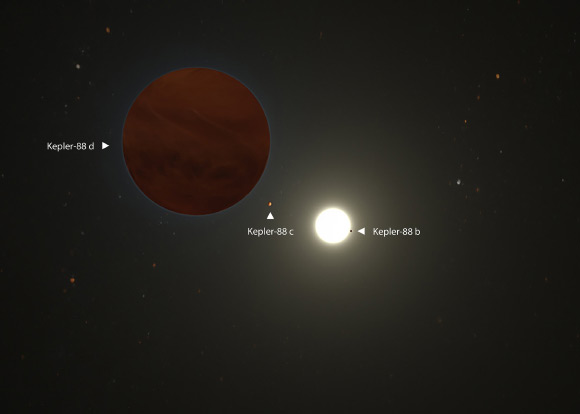Astronomers Find Long-Period Gas Giant around Kepler-88 | Astronomy – Sci-News.com
Using the High-Resolution Echelle Spectrometer (HIRES) instrument on the 10-m Keck I telescope at W.M. Keck Observatory, astronomers have discovered a giant planet in the Kepler-88 system.

An artist’s illustration of the Kepler-88 planetary system. Image credit: Adam Makarenko / W.M. Keck Observatory.
Kepler-88, also known as KOI-142, is a Sun-like star located 1,243 light-years away in the constellation of Lyra.
The star hosts two previously identified planets, Kepler-88b and c, which have a bizarre and striking dynamic called mean motion resonance.
The sub-Neptune-sized Kepler-88b orbits the star in just 11 days, which is almost exactly half the 22-day orbital period of Kepler-88c, a Jupiter-mass planet.
The clockwork-like nature of their orbits is energetically efficient, like a parent pushing a child on a swing. Every two laps Kepler-88b makes around the star, it gets pumped.
Kepler-88c is twenty times more massive than Kepler-88b, and so its force results in dramatic changes in the orbital timing of the inner planet.
The newfound planet, named Kepler-88d, orbits its parent star every 1,403 days, and its orbit is not circular, but elliptical.
At three times the mass of Jupiter, it is the most massive planet in this system.
“At three times the mass of Jupiter, Kepler-88d has likely been even more influential in the history of the Kepler-88 system than Kepler-88c, which is only one Jupiter mass,” said lead author Dr. Lauren Weiss, an astronomer in the Institute for Astronomy at the University of Hawaii.
“So maybe Kepler-88d is the new supreme monarch of this planetary empire — the empress.”
“Perhaps these extrasolar sovereign leaders have had as much influence as Jupiter did for our Solar System,” the astronomers said.
“Such planets might have promoted the development of rocky planets and directed water-bearing comets toward them.”
“We are searching for similar royal planets in other planetary systems with small planets.”
The team’s paper was published in the Astronomical Journal.
_____
Lauren M. Weiss et al. 2020. The Discovery of the Long-Period, Eccentric Planet Kepler-88 d and System Characterization with Radial Velocities and Photodynamical Analysis. AJ 159, 242; doi: 10.3847/1538-3881/ab88ca






